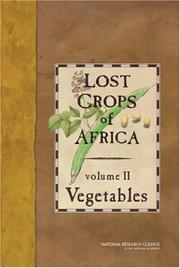| Listing 1 - 10 of 27 | << page >> |
Sort by
|
Book
Year: 1984 Publisher: Paris ACCT
Abstract | Keywords | Export | Availability | Bookmark
 Loading...
Loading...Choose an application
- Reference Manager
- EndNote
- RefWorks (Direct export to RefWorks)
Book

Year: 1981 Publisher: Wageningen (NL)
Abstract | Keywords | Export | Availability | Bookmark
 Loading...
Loading...Choose an application
- Reference Manager
- EndNote
- RefWorks (Direct export to RefWorks)
AFC Central Africa --- Cameroun = Cameroon --- traditional agriculture
Book
ISBN: 9789050111874 9050111874 Year: 2004 Publisher: Utrecht KNNV
Abstract | Keywords | Export | Availability | Bookmark
 Loading...
Loading...Choose an application
- Reference Manager
- EndNote
- RefWorks (Direct export to RefWorks)
Angiosperms --- Environmental protection. Environmental technology --- Botany --- Western Europe --- EUR Europe --- Europe --- ecological management --- fauna --- fire --- flora --- heathlands --- traditional agriculture --- traditional landscapes --- vegetation --- 711.255 --- Heide --- Angiospermen --- Plantkunde --- Milieubescherming. Milieutechnologie --- West-Europa
Book
ISBN: 9781009003957 9781316518892 9781009001861 1316518892 1009008560 100900395X 1009007793 Year: 2021 Publisher: Cambridge Cambridge University Press
Abstract | Keywords | Export | Availability | Bookmark
 Loading...
Loading...Choose an application
- Reference Manager
- EndNote
- RefWorks (Direct export to RefWorks)
Now notorious for its aridity and air pollution, Mexico City was once part of a flourishing lake environment. In nearby Xochimilco, Native Americans modified the lakes to fashion a distinctive and remarkably abundant aquatic society, one that provided a degree of ecological autonomy for local residents, enabling them to protect their communities' integrity, maintain their way of life, and preserve many aspects of their cultural heritage. While the area's ecology allowed for a wide array of socioeconomic and cultural continuities during colonial rule, demographic change came to affect the ecological basis of the lakes; pastoralism and new ways of using and modifying the lakes began to make a mark on the watery landscape and on the surrounding communities. In this fascinating study, Conway explores Xochimilco using native-language documents, which serve as a hallmark of this continuity and a means to trace patterns of change.
Horticulture --- Traditional farming --- Horticultural science --- Horticultural sciences --- Agriculture --- Gardening --- History --- Environmental aspects&delete& --- Xochimilco (Mexico City, Mexico) --- Xochimilco, Mexico --- Zochimilco (Mexico City, Mexico) --- Xochimilco (Distrito Federal, Mexico) --- Agriculture, Primitive --- Farming, Traditional --- Primitive agriculture --- Traditional agriculture --- Environmental aspects --- History.
Periodical
ISSN: 21500622 Year: 2006 Publisher: Washington, D.C. : U.S. Dept. of Agriculture, Agricultural Research Service
Abstract | Keywords | Export | Availability | Bookmark
 Loading...
Loading...Choose an application
- Reference Manager
- EndNote
- RefWorks (Direct export to RefWorks)
Dairy farms --- Traditional farming --- Grazing --- Management --- Management. --- Northeastern States. --- Agricultural systems --- Animal feeding --- Range management --- Pastures --- Rangelands --- Agriculture, Primitive --- Farming, Traditional --- Primitive agriculture --- Traditional agriculture --- Agriculture --- Dairies --- Livestock farms --- Northeast --- Northeastern United States

ISBN: 0521268680 9780521268684 Year: 1986 Volume: vol *24 Publisher: Cambridge : Cambridge university press,
Abstract | Keywords | Export | Availability | Bookmark
 Loading...
Loading...Choose an application
- Reference Manager
- EndNote
- RefWorks (Direct export to RefWorks)
Traditional farming --- Mesolithic period --- Agriculture --- Neolithic period --- New Stone age --- Stone age --- Middle Stone age --- Origin of agriculture --- Agriculture, Prehistoric --- Domestication --- Agriculture, Primitive --- Farming, Traditional --- Primitive agriculture --- Traditional agriculture --- Origin. --- History --- Asia --- Europe --- Antiquities. --- Eurasia --- Mesolithic civilization --- Agriculture. --- Origin --- Landbouw (Prehistorische). Eurazië. (Versch. onderwerpen) --- Mésolithique. Eurasie. (Mélanges) --- Agriculture préhistorique. Eurasie. (Mélanges) --- Mesolithicum. Eurazië. (Versch. onderwerpen)
Book
ISBN: 9972691934 2821844360 Year: 2009 Publisher: Institut français d’études andines
Abstract | Keywords | Export | Availability | Bookmark
 Loading...
Loading...Choose an application
- Reference Manager
- EndNote
- RefWorks (Direct export to RefWorks)
Los sistemas de andenería en los Andes centrales contribuyeron a la seguridad alimentaria y al desarrollo de las civilizaciones andinas prehispánicas. Actualmente el tejido socioeconómico andino está empobrecido, con escasa cohesión y falta de políticas coherentes que promuevan un desarrollo sustentable. El presente libro describe el origen de los sistemas de andenería en el contexto de cambio climático, geográfico, agroecológico y de ingeniería, así como su papel en la cultura y el patrimonio vivo. Se plantea que la rehabilitación de sistemas de andenería es viable en ciertas condiciones si se valora la tecnología tradicional, los servicios medioambientales que ofrecen estos sistemas, y se promueven actividades agrícolas sustentables y actividades complementarias no agrícolas que integren equitativamente a los habitantes rurales con los mercados.
Terracing --- Traditional farming --- Irrigation farming --- Rural development --- Indians of South America --- Agriculture - General --- Agriculture --- Earth & Environmental Sciences --- History --- Irrigated agriculture --- Irrigated farming --- Irrigation agriculture --- Agriculture, Primitive --- Farming, Traditional --- Primitive agriculture --- Traditional agriculture --- Agricultural terracing --- Crop terracing --- Cultivation, Terrace --- Land terracing --- Terrace cultivation --- Terraces (Agriculture) --- Arid regions agriculture --- Irrigation --- Crops and water --- Soil conservation --- Tillage --- Water conservation --- agriculture --- irrigation --- histoire --- eau --- Pérou --- Indien
Book
ISBN: 2863480146 9782863480144 Year: 1985 Publisher: Meudon: Cuénot,
Abstract | Keywords | Export | Availability | Bookmark
 Loading...
Loading...Choose an application
- Reference Manager
- EndNote
- RefWorks (Direct export to RefWorks)
Traditional farming --- Agricultural implements --- Agriculture --- Agriculture traditionnelle --- Outillage --- Agriculture, Primitive --- Farming, Traditional --- Primitive agriculture --- Traditional agriculture --- Agricultural tools --- Farm implements --- Farm tools --- Agricultural machinery --- Farm equipment --- Implements, utensils, etc. --- Tools --- Equipment and supplies --- Agriculture. Outillage. (Iconographie) --- Landbouw. Werktuigen. (Platenalbum) --- Vie rurale --- Histoire --- Instruments, ustensiles, etc
Book
ISBN: 9781350120570 9781350120556 Year: 2020 Publisher: London England : London : Bloomsbury, Bloomsbury Publishing,
Abstract | Keywords | Export | Availability | Bookmark
 Loading...
Loading...Choose an application
- Reference Manager
- EndNote
- RefWorks (Direct export to RefWorks)
"Farming Inside Invisible Worlds argues that the farm is a key player in the creation and stabilisation of political, economic and ecological power-particularly in colonised landscapes like New Zealand, America and Australia. The book reviews and rejects the way that farms are characterised in orthodox economics and agricultural science and then shows how re-centring the farm using the theoretical idea of political ontology can transform the way we understand the power of farming. Starting with the colonial history of farms in New Zealand, Hugh Campbell goes on to describe the rise of modernist farming and its often hidden political, racial and ecological effects. He concludes with an examination of alternative ways to farm in New Zealand, showing how the prior histories of colonisation and modernisation reveal important ways to farm differently in post-colonial worlds. Hugh Campbell's book has-ranging implications for understanding the role farms play in both our food systems and landscapes, and is an exciting new addition to food studies."--
Traditional farming. --- Sustainable agriculture. --- Food industry and trade. --- Food --- Food preparation industry --- Food processing --- Food processing industry --- Food technology --- Food trade --- Agricultural processing industries --- Processed foods --- Low-input agriculture --- Low-input sustainable agriculture --- Lower input agriculture --- Resource-efficient agriculture --- Sustainable farming --- Agriculture --- Alternative agriculture --- Agriculture, Primitive --- Farming, Traditional --- Primitive agriculture --- Traditional agriculture --- Processing

ISBN: 128070487X 9786610704873 0309665825 9780309665827 9781280704871 0309103339 9780309103336 0309164540 9780309164542 Year: 2006 Publisher: Washington, D.C. National Academies Press
Abstract | Keywords | Export | Availability | Bookmark
 Loading...
Loading...Choose an application
- Reference Manager
- EndNote
- RefWorks (Direct export to RefWorks)
Agriculture --- Food crops --- Grain --- Vegetables --- Indigenous crops --- Traditional farming --- Agriculture, Primitive --- Farming, Traditional --- Primitive agriculture --- Traditional agriculture --- Crops --- Native plants for cultivation --- Horticultural crops --- Horticultural products --- Breadstuffs --- Cereal grains --- Cereals --- Grains --- Botany, Economic --- Field crops --- Flour --- Food --- Seed crops --- Plants, Edible --- Farming --- Husbandry --- Industrial arts --- Life sciences --- Food supply --- Land use, Rural
| Listing 1 - 10 of 27 | << page >> |
Sort by
|

 Search
Search Feedback
Feedback About UniCat
About UniCat  Help
Help News
News